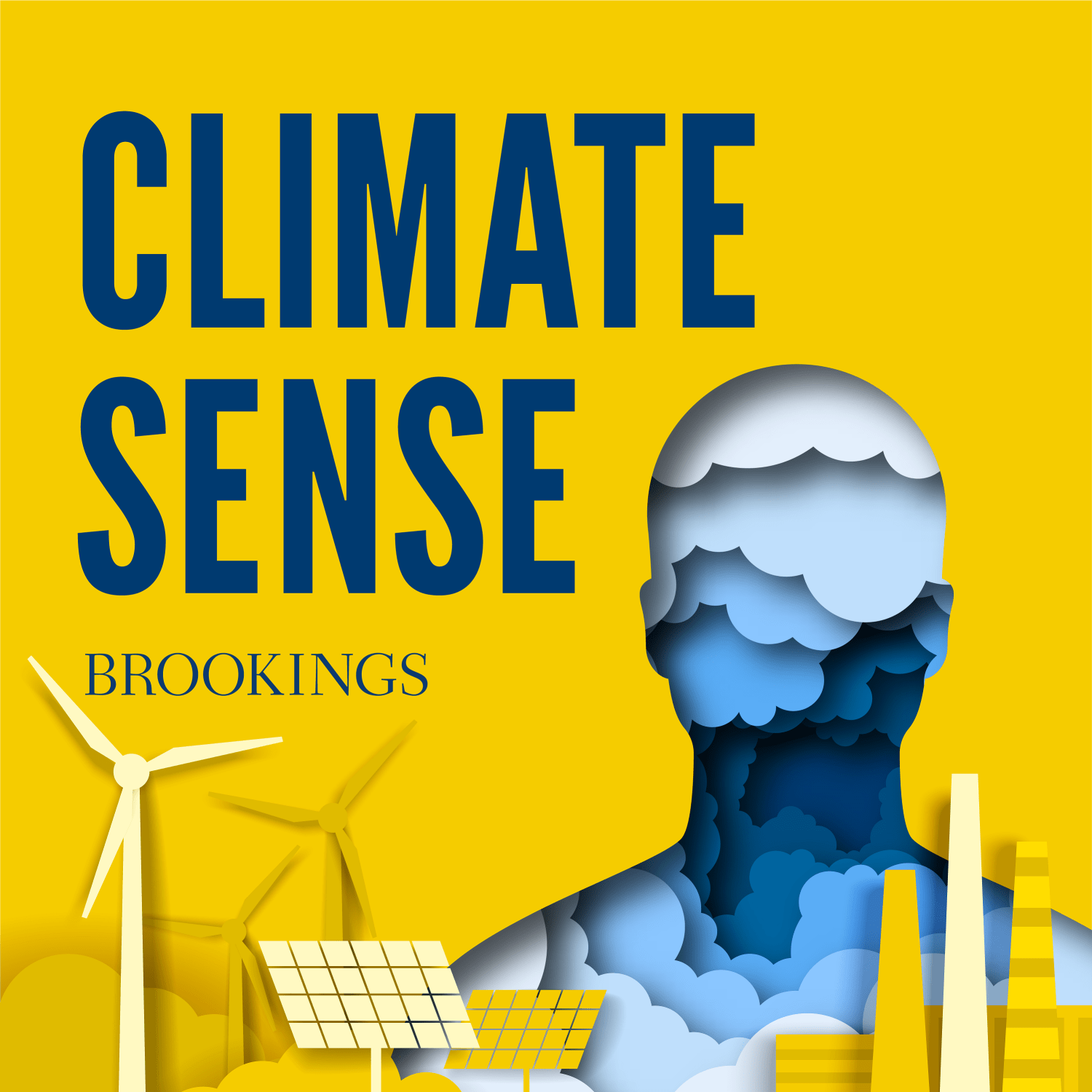The transition of our energy system away from fossil fuels will drastically increase the world’s need for certain minerals. This episode describes what some of these critical minerals are, the current state of supply, and how to ensure adequate supply in the future. Host Samantha Gross speaks with Heidi Crebo-Rediker of the Council on Foreign Relations, former U.S. Secretary of Energy Ernie Moniz, and Doug Wicks of the U.S. Department of Energy’s Advanced Research Projects Agency.
- Listen to Climate Sense on Apple, Spotify, or wherever you like to get podcasts.
- Learn about other Brookings podcasts from the Brookings Podcast Network.
- Sign up for the podcasts newsletter for occasional updates on featured episodes and new shows.
- Send feedback email to [email protected].
TRANSCRIPT
WICKS: I think you’d find that really almost all minerals are going to be critical to someone in the energy transition.
[music]
GROSS: Doug Wicks joins us again for this episode. You might remember him from the hydrogen episode earlier in the season. He’s a program director at ARPA-E, the Advanced Research Projects Agency of the U.S. Department of Energy.
Critical minerals are the materials we need to create a clean energy system—ingredients for products like batteries, solar panels, and wind turbines. I get questions about minerals all the time, both political and environmental concerns. When we think about the transition to a clean energy system, are we trading reliance on good old American fossil fuels for reliance on Chinese minerals? And what about the environmental impacts of mining all those unpronounceable minerals? We’ll talk about those issues and more in today’s episode.
[music]
I’m Samantha Gross. I’m the director of the Energy Security and Climate Initiative at the Brookings Institution, and I’ve spent my career focused on energy and environmental issues. I’ve been in Washington for more than 20 years working on energy policy in government and private industry before I came to Brookings. But I started my career as an engineer, designing technical solutions to environmental problems. My work now focuses on how to transition to a clean, zero-carbon energy system—the technical, political, and social challenges in getting from here to there.
I asked Doug to help us define what a “critical” mineral is.
[1:50]
WICKS: We have the minerals that go into batteries, and this is going to be lithium and nickel, cobalt, manganese, iron, and phosphate. And those are going to be critical. We have platinum group elements that go into fuel cells and electrolyzers. And we have materials—you’ll hear about rare earth elements, which though not very rare, are very critical towards the development of advanced electronics and magnets that are used in generating power from windmills, or the magnets that are used in electric motors and electric vehicles.
So, they’re all critical in one way or another.
GROSS: I asked Doug if there was a particular material he is most concerned about—the long pole in the tent, so to speak.
[2:40]
WICKS: The big one that we have to talk about is copper. There is going to be a need between now and 2050 for the energy transition to mine more copper than we have in history. Potentially twice as much copper as been produced in the last 4,000 years has to be produced in the next 20.
[music]
Because copper goes into everything. It goes into transmission, it’s in electric motors, it’s in circuits, so it’s pretty much everywhere. That’s going to be, I think, one of the major concerns that are out there because it’s very hard to substitute.
GROSS: We’ve said throughout this series that shifting to clean electricity and using electricity in new ways, like electric vehicles, is the center of the energy transition. And copper is the key mineral in our electricity system. It’s in everything electric, so we’re going to need a lot more of it. This shows that not all of the mineral needs in the energy transition are for new, exotic materials. Good old copper is crucial.
We are going to need a lot of a wide variety of minerals to build out a clean energy system, everything from copper to obscure minerals few of us have heard of. I consistently hear concerns about the world’s reliance on China for many critical materials.
Heidi Crebo-Rediker joins us again to talk about China’s role in the mineral space. You’ll remember her from the China episode. She’s an experienced economist and an adjunct senior fellow at the Council on Foreign Relations.
[4:25]
CREBO-REDIKER: China’s role in the supply chains here is critical. And they went beyond just the self-sufficiency in the critical minerals and rare earths to actually an ambition for domination. And it’s not an accident, right now China controls about 55% of global rare earths mining capacity, and about 85% of rare earths refining. Their dominance in this space was strategic and it was planned, and they were very smart. And it’s the result of a decades long strategy.
So, I think that it’s supercharged during the Trump administration and during the pandemic as well when they were looking at a dual circulation strategy. So, they want to both extract and process and then also have all of the various further stages of manufacturing and production of what those critical minerals and rare earths would go into.
You can look at a bunch of different examples. They refine about 60% of the world’s lithium and 80% of the world’s cobalt. Those have created really pretty dangerous dependencies. And why dangerous? Because China has a history of weaponizing economic dependency. So, you don’t want to be dependent on a country that has a tradition for many years of weaponizing dependency.
GROSS: Okay, these are some serious statistics, especially since we are relying on these materials to transform our energy system. What happened?
[5:57]
CREBO-REDIKER: How did we get here? We were just totally not paying attention to what were market failures on our side. And Chinese had made strategic decisions decades in the making. And on our side, it really was market failure. So, they put long-term goals over short term profits.
And take the DRC as an example, Democratic Republic of Congo, and cobalt. Cobalt mining out of DRC is the largest mines in the world. And China negotiated minerals for infrastructure, so they got control of the mines. And they also invested in what I would call vertical integration. So, they do the refining, the processing, the manufacturing. And that was all strategic.
[music]
We’ve known for a long time that the China has used massive subsidies in strategic industries. And as a result of that, we’ve seen oversupply in markets, domination of markets, but also oversupply.
GROSS: The Democratic Republic of Congo wanted infrastructure and China wanted cobalt, so they cut a deal. But we have to remember that deal wasn’t good for everyone. Working conditions for miners can be just awful, a subject we’ll come back to later.
At the same time China was viewing minerals as a source of strategic advantage, the United States was moving away from the business. Doug Wicks explains.
[7:28]
WICKS: The United States had for a long time just decided to outsource all of its mining overseas. And there was a conscientious decision back in the 1990s to stop supporting our metals mining and refining industries.
And I think the realization is now there. We have my program taking place, we have a bunch of other efforts within Department of Energy that are focusing on this to say what future innovations are needed for mining to make it go?
[music]
GROSS: China has a huge head start on controlling the supply, both extraction and refining, of many key materials for the energy transition. Given that we can’t go back and change where we are, what do we do now? How do we develop new sources of supply given China’s dominance today?
[8:28]
CREBO-REDIKER: What I would pay attention to now is that because they have such a huge domination in this space, they’re crashing commodity prices and actually stockpiling right now. So, because they are a non-market economy, they’re ramping up production way, way, way beyond demand for many of these materials, particularly cobalt, but also for nickel there’s just a huge glut right now.
And what that means for market and private companies is that you either go out of business or you have a constraint to borrow, you can’t invest. And you have Chinese state companies that are looking to make acquisitions of those companies that are struggling.
So, now that you have lithium, cobalt, and nickel prices just really flatlining right now. And China, meaning China Inc., is actually buying those at a dirt-cheap price for their own stockpile.
GROSS: Wow! Because China has cornered the market on materials, they’ve cratered prices and can now buy up their competitors on the cheap. This is a strategy that only works with government support—private companies generally can’t afford to lose money like that, plus this would be a huge antitrust violation in the United States. The United States and other countries are finding ourselves in a battle with China Incorporated, rather than individual Chinese companies. What can we do in this situation?
[9:59]
CREBO-REDIKER: I think it’s high time that we as U.S. consider a strategic reserve of these strategic minerals and rare earths so that we don’t find ourselves on the other side of a different kind of weaponization which is using the market against us.
I think that the Inflation Reduction Act was actually a huge shot in the arm for U.S. ability to counteract some of what’s happening.
GROSS: Minerals strategy in the Inflation Reduction Act of 2022 focuses on strengthening supply chains and diffusing the risk of Chinese control of many supply chains, especially the minerals refining step—going from a raw ore to a useful material. It provides greater subsidy benefits to goods produced with minerals from the United States or our free trade partners.
[10:50]
CREBO-REDIKER: We’re into kitchen sink territory, in both what we do domestically in our investment, but also in our strategy of working with like-minded countries in different partnerships. And we’ve been doing that, I think, pretty successfully.
We have a lot of resources in the United States, particularly with lithium and also one of the other materials, graphite, for batteries. We’ve seen some significant support from the Department of Energy in investing in graphite.
You’ve even seen the Department of Defense provide Defense Production Act purchase agreements to a graphite facility in Alaska this past year.
So, I think we’re using federal and state initiatives, we’re using loan guarantees and loans and grants and tax incentives. And, you know, I would say where we need a kitchen sink approach it’s basically we’re doing the kitchen sink of the federal and state incentives as well.
[music]
The other thing I would say is that we’re doing a very good job on partnerships. We’ve been able to coordinate strategic partnerships with the U.S. and Japan. We have a critical minerals agreement with the U.S.-EU. And then we basically have a buyer’s club of 14 countries plus the EU that’s the Minerals Security Partnership. And that includes the UK and Canada and Australia and India. And that’s really to create resilient supply chains.
So, I think we’re doing what we should be doing to counter, but we’ll have to see if it’s really enough.
GROSS: This seems like good advice—diversify the supply chains for these critical materials. There will clearly be demand for materials produced outside the Chinese system. The big question is, how long will these new supply chains take to develop? You can’t build a mine or a processing facility overnight. Doug describes the challenges of developing new mineral sources.
[12:52]
WICKS: I think one of the real challenges is the time it takes to develop the supply chain. The process of discovering an ore body, mapping the ore body, getting things permitted, and then doing the construction on the mine itself can be a 10- to 20-year process. So, it’s incredible lead times. And there’s a lot of stress right now due to the fact that the energy transition is going to increase demand across almost the entire mineral value chain over the next 20 years.
I’ve heard it said, and I think it’s correct, there’s really not a shortage of minerals, there’s just a shortage of minerals that are ready to be mined.
GROSS: Is there some way to get new supply more quickly? We’re in a hurry to deal with climate change, and we sure don’t want to wait 10 to 20 years for new minerals supply to develop. What can we do in the meantime?
[13:51]
WICKS: I come at this approach from the technology standpoint. A focus of my programs being how do we increase the recovery from existing deposits. We get all the metal that’s in there; how do we get multiple metals out of the same mine? Typically mines go after one key metal.
For example, a mine out in Utah, a copper mine, has just instituted a process to not only recover copper and silver and gold that they’ve been looking at, but now they’re looking at saying, can we recover tellurium? And tellurium is used in making solar cells. And so, it gives us a domestic source for tellurium to go in there. So, the more we can use that there in the big mines, it might help us in not having to open smaller mines.
If we use the mines we have now more efficiently, first of all, it’s not going to solve the problem. The big challenges are still going to be there. When I look at copper, for example, when we process the ore to get the copper out, typically we’re only recovering 60 to 80 percent of the actual copper that’s in that ore.
So, developing methods to do that will do a couple of things. Hopefully, it alleviates some of the demand for new mines to be developed, but it’s not going to do all of it.
[music]
And probably most importantly, it increases or improves the economics of a mine such that if we can go after lower and lower concentrations in the same mine then that’s the best way to go because we don’t have to start up and don’t have all the permitting issues. So, extending the life of mines is a key thing.
GROSS: Getting more out of existing mines is a key way to increase supply in a way that has environmental and social benefits too. We sometimes forget that even as we transition away from fossil fuels, extraction will still be important. Getting as much as we can out of what we extract is key.
[16:07]
WICKS: Then the other options, really, are how do we discover deposits and map them faster? And we have programs in that area that we look at to say, how do we find the best deposits in the most accurate and fast way? We’re definitely going to be in the extraction business. And the challenge from a technology standpoint is how do we do this in a way that addresses environmental, social, and economic concerns?
And one of the focuses that we look at within my current programs at ARPA-E, but also ones that are being developed across DOE, is how do we use more of the material that is dug out of the ground? So, if you look at a copper mine, for example, the concentration of copper in the processed ore is less than 1%. So, that means 99% of the material ends up as waste.
And we look at this and say, okay, how do we approach this in a way that we use everything that we take out of the ground? If you look at a barrel of oil, well over 99% of that ends up in a product of some type. And we need to do the same thing with mining. We need to, when we dig something up, use all of it because, probably the major concern that people have about mining is the waste that’s left behind.
And so, how do we minimize that waste by using more of it for different uses? And make sure that the waste that’s left behind is as inert and environmentally safe as possible?
GROSS: Heidi Crebo-Rediker raises more environmental and safety issues around the mining of critical minerals.
[18:00]
CREBO-REDIKER: We do have our own sources of lithium and graphite and other rare earths here in the U.S. We used to be a massive producer of rare earths out of a mine in California. But, you know, you have to remember that for rare earths, they usually form alongside radioactive elements and so it produces radioactive waste. So, you do want to be careful about worker protections. And that was one of the reasons that many countries around the world, for the extraction and the refining, outsourced to China.
So, the mining is by definition a dirty business and other countries do it well. And you don’t want to speed the process if you have to compromise on environmental and worker protections, because the consequences are pretty significant.
[music]
The rare earths are not actually rare. They’re actually super abundant. And so, it’s just a matter of finding out how to access them in the cleanest, most environmentally acceptable way. But absolutely, I think, we want to be mindful that we don’t want to slow the process down to the point that 15 years from now we’re wondering why it is that, that we don’t have that mining capacity in in the U.S.
GROSS: I get a lot of questions about the environmental and social impacts of minerals extraction. Mining can be a very dirty business. Given this, is the clean energy transition really clean when we take into account all the materials we need to make it happen?
[19:35]
WICKS: I would look at it and say that you have to look at the lifespan of the materials. Yes, we have to be concerned about the impacts of mining, and we need to improve those. But the amount of stuff that we extract from the earth to do mining of minerals is going to be much smaller than the amount of hydrocarbons that we’re sucking out of the earth, or we’re pulling out of mining out of the earth. The amount of coal, oil, and natural gas we remove from the earth every year dwarfs what we’re doing in mineral mining.
And when we build a solar cell, that solar cell is going to operate for decades, potentially. And at the end of life, it can be recycled. Yes, we need to develop the recycling methods to do that. But a gallon of gasoline it has a life of 30 miles in your car, and it cannot be reused. And so, it’s a one-shot activities, whereas the mining, we’re going to do a lot of mining, but these resources will continue to provide energy for literally decades into the future.
GROSS: An additional advantage to mining and refining minerals in the United States or our trading partners is that environmental and labor standards tend to be stronger in those countries.
[21:02]
WICKS: The other challenge really it comes back to is that we as a society have to accept that doing things in an environmentally and socially responsible method costs more—or may cost more, it doesn’t have to, but it may cost more, but it’s something that has to be done.
There are a lot of mineral production activities around the world where societal and environmental concerns are not addressed. And, when we look at our smartphones, we don’t really think about where the 56 minerals in there came from. Were they mined in a way that’s socially responsible? Or were they mined in a way that there’s not an environmental disaster left behind for the next generations?
I think from a technical standpoint, I’m very optimistic that we can develop methods that allow us to extract minerals in environmentally and socially responsible methods.
GROSS: Creating new supply chains for our mineral supply is a tall order, but it’s good to remember that it wouldn’t be the first time that the United States has seen a tidal wave of innovation change its energy situation. In fact, this just happened a few years ago in terms of oil and natural gas production.
[22:24]
WICKS: I would tell people to look back to when ARPA-E was founded 15 years ago, which is not that long ago. When it was first proposed under the Bush administration, the strategic threat at that time is we were importing 60% of our oil and were getting ready to import the vast majority of our natural gas. That’s less than 20 years ago.
Today, we’re a net exporter of oil products, natural gas products—actually we’re the largest exporter of natural gas in the world. And that really came because of technical innovations. And now we’re faced with the same economic security or national security issue that we import the vast amount of our critical minerals for the energy transition.
I would say that we have the innovation capacity here in the United States that should we choose to we could, between ourselves and our allies, get off of that supply chain.
I am very optimistic that as the demand increases, solutions will come out, either through substitutions or through new methods of extraction and processing that will allow us to fulfill this.
[music]
So, I’m very optimistic. I think that the technical strength of the United States have focused on it. Not just the United States, it’s our allies also. And we have to look at this and say, we’re not in this alone. We’re in there with Europe and Canada and Australia, and many other countries, where minerals can be developed once the decision is made to do so.
GROSS: Doug points out the importance of innovation and new technology. We’re looking for new tech not just in extraction and processing. Can we make batteries, wind turbines, or electric motors with different materials? Can we engineer around these materials that China has cornered the market on, or that are environmentally challenging to produce? Heidi explains.
[24:34]
CREBO-REDIKER: I’m a huge believer in the fact that technology is going to catch up very, very quickly and actually make some of these big questions on mining less urgent. Because we already are seeing certain types of batteries, LFP batteries, are cobalt free.
[music]
So, that actually takes a lot of pressure off of the cobalt mines, which, you know, if you look at what we’ve seen in the DRC it’s been a horrible challenge with child labor and women and children digging with bare hands in really horrific conditions. So, if you can eliminate cobalt from batteries, which we already do in LFP batteries, that takes the pressure off significantly.
GROSS: An LFP battery is lithium-iron-phosphate—a slightly different battery chemistry for electric vehicles that not only doesn’t use cobalt, it’s also more durable and doesn’t cause fires in the way that cobalt-containing batteries can. Today, LFP batteries can carry less energy per unit of weight then cobalt-containing batteries, meaning that vehicles that use them have a shorter range. But engineers are working to close that gap, and thus decrease demand for problematic cobalt.
[25:59]
CREBO-REDIKER: So, I think that in batteries that the Chinese are very far ahead in the technology breakthroughs. But we are as well. And so, I would put stock in the new material space where we can come up with different products that reduce the critical mineral requirements, or just they might eliminate altogether some of the critical or scarce materials. I just see this being an easy path forward and investing in R&D is really the best place to get them there.
GROSS: In addition to substituting for some critical minerals, we can recycle them.
CREBO-REDIKER: And then the other thing is you can recycle these materials. So, to the extent that we invest in recycling capacity, which we’re already doing, we need to do a lot more of it. The Department of Energy has provided several support mechanisms for large-scale recyclers to be stood up, particularly out in Nevada around where the lithium mining is happening.
GROSS: Sounds great, but Doug explains that recycled supply might take a while.
[27:08]
WICKS: One of the challenges we’re going to see is that the materials to recycle are going to be delayed for a period of time as they remain in use. And so, if you think about a car, the battery in that car is going to stay there for 10 to 15 years. And so, as we ramp up, we’ll begin to see recycling, but this is going to really begin to have impact on total supply in the 2040s, just because we’re filling up that pipeline with materials that will be there for a long time and they’ll be reaching end of life decades in the future.
Yeah, I mean if you want to make Teslas only from recycled Teslas, that means you’d be only selling a thousand Teslas this year.
[music]
The methods are being developed now. Are they perfect? No. Are they improving rapidly? Yes. But they’re really not going to impact the requirements for the upcoming energy transition. But they will be available for redeployment in the future.
GROSS: I love Doug’s description here. Recycling is great and necessary, but it won’t get us out of today’s supply needs. We need new materials to fill the pipeline, get us started, and then we’ll have more recycled material available later.
To wrap up this episode, let’s hear from Ernie Moniz, former U.S. secretary of energy who has been on a couple of episodes this season. I asked him to give his diagnosis of the U.S. position in critical minerals.
[28:56]
MONIZ: God did not put all of these minerals under China. But in general, what China has done is make the choice to build the industry to refine these metals and minerals, and it’s a choice that we can make and others can make.
There’s no doubt that there is a real kind of energy security issue around lots of metals and minerals. Originally those discussions tended to focus around things like rare earths, but now people are realizing that, yeah, rare earths are an issue, but so is cobalt and nickel and lithium and copper. We are going to have tremendous needs around these.
This dependence upon metals and minerals is not going away. I hope we do not get into, let’s call it protectionism. But rather I do hope that we get into better hygiene for critical supply chains, and that would include metals and minerals. The same way in the 1970s when we had the oil shocks, the response to that really was diversification of sources. We need diversification of sources, diversification of refining and processing capabilities for metals and minerals. And to me that’s not protectionism, that is in everybody’s interest for good hygiene supply chains in what is going to be a rapidly expanding global market.
GROSS: I really like what he has to say here. Not protectionism, but diversification and expansion of sources. We’re bound to need a lot of these materials, meaning that there is plenty of market share to go around. And you hope that new sources with better environmental and social standards raise the bar for everyone.
[music]
Many thanks to the experts I talked to in this episode.
Climate Sense is brought to you by the Brookings Podcast Network. Fred Dews is the producer; Gastón Reboredo the audio engineer. Thanks also to Kuwilileni Hauwanga, Daniel Morales, and Louison Sall, and to the communications teams in Brookings Foreign Policy and the Office of Communications. Show art was designed by Shavanthi Mendis.
You can find episodes of Climate Sense wherever you get your podcasts and learn more about this show at Brookings dot edu slash Climate Sense Podcast. You’ll also find my work on climate change and research from the Brookings Initiative on Climate Research and Action on the Brookings website.
I’m Samantha Gross, and this is Climate Sense.
The Brookings Institution is committed to quality, independence, and impact.
We are supported by a diverse array of funders. In line with our values and policies, each Brookings publication represents the sole views of its author(s).









Commentary
PodcastCritical minerals for the energy transition
Listen on
Climate Sense Podcast
October 17, 2024